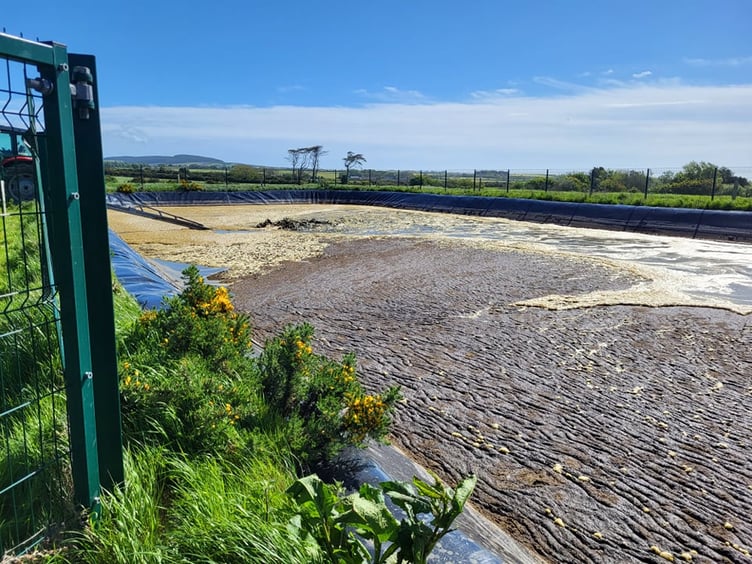With fertiliser prices at an all-time high it has never been more important for dairy farmers to make the best possible use of their slurry.
The Coole family, at Ballamodha Mooar, have made a major investment in slurry efficiency that is really starting to pay off.
Slurry, or liquid manure from cows, is an extremely valuable fertiliser, containing nitrogen which is a key element in nourishing a good grass crop.
Like many farmers, the Cooles were storing their slurry in four-metre tanks underneath the cow sheds. These filled every 10 days and the slurry had to be emptied and spread on the fields, whatever the weather and whatever the time of year. They were also using a traditional splash plate spreader for dispersing the slurry over the fields.
In 2019 they made a major investment in slurry efficiency with the building of a slurry lagoon and the purchase of a dribble bar to go on the back of the tractor for dispersing the slurry.
Kayleigh Coole says: ‘We did get a grant from the government but it was still a significant expenditure. The lagoon was built to increase our storage capacity because slurry is such a valuable resource.
‘As we’ve increased our cow numbers our slurry storage needed to increase as well, so that we can use it correctly in the best conditions and at the best time of year. Now we can use it when it will be most valuable to us and to the land. We can choose when to do it, rather than needing to do it.’
The lagoon holds 500,000 gallons, the same volume as an Olympic swimming pool, and all the slurry from the cow housing is now piped directly into it.
Kayleigh says: ‘Chris Kneale’s Rural Business Consultancy helped us to calculate the capacity we would need – you don’t want to get it wrong.
‘It will hold all of our slurry over the winter so we’ve no need to spread it in the winter any more, we can save it until early spring which is the optimum time for spreading.’
The lagoon is quite a sight: at around 60m x 20m, it looks vast. The site was chosen after an environmental survey and the lagoon is plastic lined so that no leaching into surrounding water courses can take place.
The number of accidents involving people falling into even smaller slurry pits are well documented and the whole lagoon is surrounded by a sturdy metal fence.
Sitting nearby is the tractor-driven slurry spreader, specially designed so that it doesn’t rip the plastic lining while it is at work. It takes only minutes to stir the whole lagoon, which prevents a thick crust being formed on the top.
The Cooles also use Slurry Bugs, an inoculant which works over time to add non-pathogenic bacteria and enzymes to the slurry, to drive the breakdown of crusts and solid matter (fibre). They help to further break down solid matter, releasing nutrients including nitrogen and potassium from the solid material. Kayleigh says: ‘We’ve also had our slurry analysed so we can see exactly what is being put on the ground and what we have to make up in artificial fertiliser, which is hopefully a lot less this year.’
Agricultural contractor, Adam Kinvig, pulls up the tractor to one of the lagoon gates and hooks up the slurry tanker to the pipe emerging from the lagoon. It takes about five minutes to full the tanker. Then he is off, spreading the slurry onto the fields using a dribble bar instead of the traditional splash plate spreader.
A splash plate, which was used on all farms until recently, flings the slurry into the air in a wide arc behind the tractor: this causes it to lose nutrient value, especially nitrogen, and also creates that distinctive smell.
The dribble bar puts the slurry directly onto the ground, in lines by the plants’ roots, rather than on the leaves. This means far less smell, better nutrition for the plant, and the field can be used very quickly afterwards for grazing stock.
Dougie Coole says: ‘Adam has taken the dribble bar to other dairy farms on the island they have hired it off us and tried it to see how it works in their system.’
So, with the dramatic increase in fertiliser prices, does this system mean that farmers can stop using fertiliser altogether?
‘Depending on how well stocked you are you could just get away with slurry and lime but the amount of stock that we have, you need more,’ Dougie adds.
At the very least it reduces the use of artificial fertiliser with consequent benefits for wildlife and the environment so it’s good all round.
The Cooles, like everybody else, could have had no idea when they started building their slurry lagoon of how the world was about to be turned upside down, with Covid and the war in the Ukraine, and how all this would contribute to fertiliser costs rising in such a dramatic and unprecedented way.
Kayleigh says: ‘We couldn’t predict it that in a year’s time it would have paid off as much as it has done.’



.jpeg?width=209&height=140&crop=209:145,smart&quality=75)

Comments
This article has no comments yet. Be the first to leave a comment.